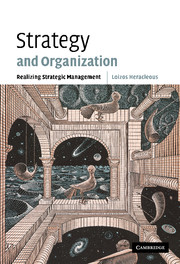Book contents
- Frontmatter
- Contents
- List of figures
- List of tables
- Preface
- I Bases of strategic management
- II Realizing strategy
- III Current themes and applications
- 9 State ownership, privatization, and performance
- 10 Does corporate governance make a difference to organizational performance?
- 11 Types of inter-organizational networks and the strategic roles of directors
- 12 Organizing for the future
- Index of names
- Index of subjects
- References
12 - Organizing for the future
Published online by Cambridge University Press: 11 May 2010
- Frontmatter
- Contents
- List of figures
- List of tables
- Preface
- I Bases of strategic management
- II Realizing strategy
- III Current themes and applications
- 9 State ownership, privatization, and performance
- 10 Does corporate governance make a difference to organizational performance?
- 11 Types of inter-organizational networks and the strategic roles of directors
- 12 Organizing for the future
- Index of names
- Index of subjects
- References
Summary
This chapter begins by addressing the characteristics of the shifting competitive landscape, significantly influenced by the forces of globalization and information and communication technologies (ICT). It expands on the crucial role of leadership for guiding organizations towards competitive success, especially the ability effectively to balance strategic and organizational tensions and paradoxes. The implications of the new competitive environment for organizational design are then addressed, especially how firms can develop strategic flexibility. Intensified competitive churning leads to higher levels of uncertainty and risk. The chapter suggests that even though structured tools exist to help managers deal with such risk, the most effective defense at a strategic level is building sound strategic thinking and implementation capabilities. The chapter ends by suggesting that notwithstanding the hype and popular assertions that the old rules of strategy are not applicable any more, the opposite is true. Strategic clarity based on established principles is now more crucial than ever.
The new competitive landscape and its strategic implications
The competitive environment of most industries has been influenced or even restructured by the two key forces of globalization and technological advancement (Hitt 2000; Hitt et al. 1998). Globalization has been spurred on by world-wide economic development, the opening up of overseas markets to global competition, and the advancement of ICT. Even though such technologies can have some positive effects on industry structure, they are often detrimental to industry profitability because they lead to intensified competition.
- Type
- Chapter
- Information
- Strategy and OrganizationRealizing Strategic Management, pp. 211 - 221Publisher: Cambridge University PressPrint publication year: 2003

